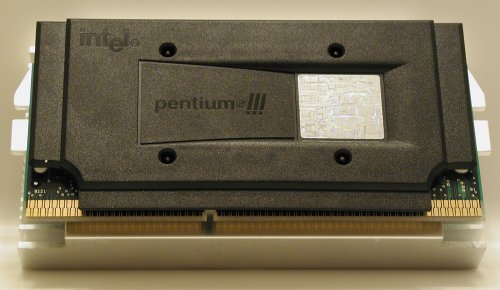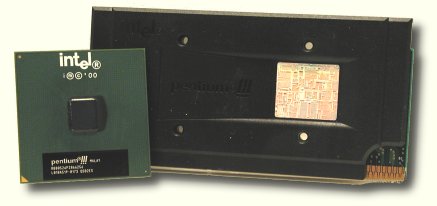Intel's Next Paper Release: The Pentium III at 1133 MHz
Introduction
It might sound funny to a lot of you when we are writing 'poor Intel is hurting'. I do agree that Intel is having its hardest time since IBM made the incomprehensible decision to equip their 'PC' with Intel's badly engineered 8088 processor instead of Motorola's far superior 68k solution many many years ago. The 'older' ones of you might still remember that IBM's PC was the one and only reason why two IT companies with rather mediocre products finally became more important than good old IBM itself. If you wonder why we all have to put up with Intel's as well as Microsoft's unpleasant business practices then please go ahead and blame IBM. I guess that IBM's decision makers from that time have often wished there was a time machine, which could straighten out all their mistakes from the past.
Intel's Revenge
Now while Microsoft had and still has a lot of fun with the FTC, Intel has been facing a very tough enemy in AMD, since the formerly Austin based company introduced its Athlon processor last year. The very worst thing in terms of prestige damage happened back in Spring 2000, when AMD was the first x86-processor maker to introduce a CPU that runs at 1 GHz = 1000 MHz clock speed. Big Chipzilla countered with the release of the Pentium III at 1 GHz two days later, but this CPU was so unavailable that not even the press was equipped with any samples. Today, some four months later, the Giga-Pentium III is still hardly available anywhere and now Intel considered it a particularly smart move to go ahead and introduce another Pentium III version that hardly anyone will be able to get, the Pentium III at 1.133 GHz.
AMD Has No Reasons To Be Too Bothered
Different to Intel, AMD was actually well capable of shipping their Giga-Athlon and today they are happily selling their new Athlon, based on the 'Thunderbird ' core at 1 GHz as well. The fact that the vast majority of Giga Hertz systems are actually equipped with Athlon rather than Pentium III processors made AMD so confident, that they couldn't really be bothered to beat Intel in the race for the next speed grade beyond 1 GHz. While the normal users out there might not know about this, people in the hardware reviewing scene are well aware of the fact that AMD has shipped their 1.1 GHz Thunderbird samples to publications already weeks ago, while Intel was just able to get the rare samples of the Pentium III 1.133 GHz to the reviewers in the second half of last week. AMD is planning to launch their Thunderbird-Athlon 1.1 GHz in late August, giving us the chance to review the sample with ample time. Intel however shipped out their samples in the last minute, which proves who of the two companies is really able to actually produce 'Beyond-Giga-Processors' right now.
Taking A Step Backwards? New 'Beyond-Giga' Pentium III Comes Only For Slot1
There is already one rather annoying thing about Intel's new 'Larger-Than-Life' processor. Just as its older brother at 1 GHz it comes as Slot1 version only. Technically there is no reason whatsoever and from a company philosophy point of view it doesn't seem to make any sense as well. After all we have learned that Intel wants to abandon Slot1 as soon as possible and switch all their latest processors to the FC-PGA package for Socket370. The latter is easier to handle, it's more future proof and more versatile, since you can run it in both, Slot1 (with adapter) as well as Socket370. Slot1-models can only be plugged into Slot1-platforms and those are slowly but surely dying out. Why is Intel still supplying Pentium III at 1 and 1.133 GHz for Slot1 only? I guess there are a few reasons to consider. First of all those processors are produced in very small numbers only, which results in a complete lack of those types in the retail market. This market however is the one where people make a difference between FC-PGA and Slot1, so why would Intel care? Instead those few processors are only going into the OEM-channel, ending up in ready-built systems. The rules in this arena are very different to the retail market. It might well be that OEMs prefer Slot1 for some unfathomable reason. The last and possibly most likely reason that I can see is the fact that by keeping the Giga-and Beyond -Pentium III processors at Slot1 only, Intel makes sure that nobody will combine those CPUs with its new PC133 SDRAM based chipset i815 (Solano). After all Intel is still trying to make a point that Rambus is the best memory solution, even though their own benchmarks prove the opposite , and by making a Giga-Solano combination impossible Rambus should be very pleased. Whatever the reason may be, Slot1 is dying out! Look at the websites of motherboard makers and you will see that all the new products are Socket370 solutions. Going for a Slot1 platform right now is betting on the wrong horse.
Horrible Instability Without The Latest Micro Code Update
I received my sample on Friday, facing working-weekend No. XXX of this year. However, things turned out to be different. Intel was actually shipping these 'More-Than-Giga' samples together with a specially prepared VC820 motherboard and Rambus memory. This is very unusual for Intel, since they normally supply you just with the CPU. In my case I was lucky to receive the processor sample, but the motherboard never made it to me. This would normally not have been an issue, because I anyway test processors on my proven, reliable and high performing own test beds, but this time I was unfortunately utterly unable to run any decent benchmark on any of my Slot1 platforms.
As it turns out Intel had to use all kinds of tricks to get Coppermine to 1133 MHz. Any motherboard that has not got the special micro code update for this very processor will ultimately fail. What is 'micro code update'? Well, all of Intel's 6th-generation processors have a little area that can store some software ('micro code') to deal with processor bugs right inside the CPU. Usually the motherboard BIOS loads this software into the processor right after boot-up. Each time Intel finds a new bug they try to create a new little software patch that is called 'micro code update'. These 'micro code updates' make the processor more reliable, but they always cost a bit of performance, because they basically turn off some internal features. As it turns out the new Pentium III at 1133 MHz is utterly unable to run reliably at this speed without a brand new micro code update, while it performs fine if you 'underclock' it to e.g. 850 MHz. So if anyone wants to make you believe that Intel was easily able to bring the 'Coppermine' to 1.133 GHz then this guy is either incompetent or a liar.
Get Tom's Hardware's best news and in-depth reviews, straight to your inbox.

